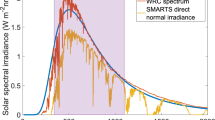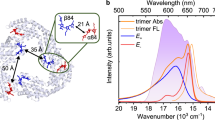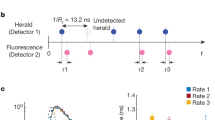Abstract
Photosynthesis makes use of sunlight to convert carbon dioxide into useful biomass and is vital for life on Earth. Crucial components for the photosynthetic process are antenna proteins, which absorb light and transmit the resultant excitation energy between molecules to a reaction centre. The efficiency of these electronic energy transfers has inspired much work on antenna proteins isolated from photosynthetic organisms to uncover the basic mechanisms at play1,2,3,4,5. Intriguingly, recent work has documented6,7,8 that light-absorbing molecules in some photosynthetic proteins capture and transfer energy according to quantum-mechanical probability laws instead of classical laws9 at temperatures up to 180 K. This contrasts with the long-held view that long-range quantum coherence between molecules cannot be sustained in complex biological systems, even at low temperatures. Here we present two-dimensional photon echo spectroscopy10,11,12,13 measurements on two evolutionarily related light-harvesting proteins isolated from marine cryptophyte algae, which reveal exceptionally long-lasting excitation oscillations with distinct correlations and anti-correlations even at ambient temperature. These observations provide compelling evidence for quantum-coherent sharing of electronic excitation across the 5-nm-wide proteins under biologically relevant conditions, suggesting that distant molecules within the photosynthetic proteins are ‘wired’ together by quantum coherence for more efficient light-harvesting in cryptophyte marine algae.
This is a preview of subscription content, access via your institution
Access options
Subscribe to this journal
Receive 51 print issues and online access
$199.00 per year
only $3.90 per issue
Buy this article
- Purchase on Springer Link
- Instant access to full article PDF
Prices may be subject to local taxes which are calculated during checkout



Similar content being viewed by others
References
Green, B. R. & Parson, W. W. eds. Light-Harvesting Antennas in Photosynthesis (Kluwer, Dordrecht, 2003)
Scholes, G. D. Long-range resonance energy transfer in molecular systems. Annu. Rev. Phys. Chem. 54, 57–87 (2003)
Jang, S., Newton, M. D. & Silbey, R. J. Multichromophoric Förster resonance energy transfer from B800 to B850 in the light harvesting complex 2: evidence for subtle energetic optimization by purple bacteria. J. Phys. Chem. B 111, 6807–6814 (2007)
Cheng, Y. C. & Fleming, G. R. Dynamics of light harvesting in photosynthesis. Annu. Rev. Phys. Chem. 60, 241–262 (2009)
van Grondelle, R. & Novoderezhkin, V. I. Energy transfer in photosynthesis: experimental insights and quantitative models. Phys. Chem. Chem. Phys. 8, 793–807 (2006)
Engel, G. S. et al. Evidence for wavelike energy transfer through quantum coherence in photosynthetic systems. Nature 446, 782–786 (2007)
Lee, H., Cheng, Y. C. & Fleming, G. R. Coherence dynamics in photosynthesis: protein protection of excitonic coherence. Science 316, 1462–1465 (2007)
Mercer, I. P. et al. Instantaneous mapping of coherently coupled electronic transitions and energy transfers in a photosynthetic complex using angle-resolved coherent optical wave-mixing. Phys. Rev. Lett. 102, 057402 (2009)
Feynman, R. P. Space-time approach to non-relativistic quantum mechanics. Rev. Mod. Phys. 20, 367–387 (1948)
Jonas, D. M. Two-dimensional femtosecond spectroscopy. Annu. Rev. Phys. Chem. 54, 425–463 (2003)
Brixner, T., Mancal, T., Stiopkin, I. V. & Fleming, G. R. Phase-stabilized two-dimensional electronic spectroscopy. J. Chem. Phys. 121, 4221–4236 (2004)
Cho, M. H. Coherent two-dimensional optical spectroscopy. Chem. Rev. 108, 1331–1418 (2008)
Abramavicius, D. et al. Coherent multidimensional optical spectroscopy of excitons in molecular aggregates; quasiparticle versus supermolecule perspectives. Chem. Rev. 109, 2350–2408 (2009)
Spear-Bernstein, L. & Miller, K. R. Unique location of the phycobiliprotein light-harvesting pigment in the cryptophyceae. J. Phycol. 25, 412–419 (1989)
van der Weij-De Wit, C. D. et al. Phycocyanin sensitizes both photosystem I and photosystem II in cryptophyte Chroomonas CCMP270 cells. Biophys. J. 94, 2423–2433 (2008)
Wilk, K. E. et al. Evolution of a light-harvesting protein by addition of new subunits and rearrangement of conserved elements: crystal structure of a cryptophyte phycoerythrin at 1.63-Ångstrom resolution. Proc. Natl Acad. Sci. USA 96, 8901–8906 (1999)
Wedemayer, G. J., Kidd, D. G., Wemmer, D. E. & Glazer, A. N. Phycobilins of cryptophycean algae: occurrence of dihydrobiliverdin and mesobiliverdin in cryptomonad biliproteins. J. Biol. Chem. 267, 7315–7331 (1992)
Mirkovic, T. et al. Ultrafast light harvesting dynamics in the cryptophyte phycocyanin 645. Photochem. Photobiol. Sci. 6, 964–975 (2007)
Scholes, G. D. & Rumbles, G. Excitons in nanoscale systems. Nature Mater. 5, 683–696 (2006)
Doust, A. B. et al. Developing a structure-function model for the cryptophyte phycoerythrin 545 using ultrahigh resolution crystallography and ultrafast laser spectroscopy. J. Mol. Biol. 344, 135–153 (2004)
Scholes, G. D. et al. How solvent controls electronic energy transfer and light harvesting. J. Phys. Chem. B 111, 6978–6982 (2007)
Rhodes, W. Radiationless transitions in isolated molecules. the effects of molecular size and radiation bandwidth. J. Chem. Phys. 50, 2885–2896 (1969)
Cheng, Y. C. & Fleming, G. R. Coherence quantum beats in two-dimensional electronic spectroscopy. J. Phys. Chem. A 112, 4254–4260 (2008)
Rackovsky, S. & Silbey, R. Electronic-energy transfer in impure solids. 1. 2 molecules embedded in a lattice. Mol. Phys. 25, 61–72 (1973)
Hwang, H. & Rossky, P. J. Electronic decoherence induced by intramolecular vibrational motions in a betaine dye molecule. J. Phys. Chem. B 108, 6723–6732 (2004)
Franco, I., Shapiro, M. & Brumer, P. Femtosecond dynamics and laser control of charge transport in trans-polyacetylene. J. Chem. Phys. 128, 244905 (2008)
Collini, E. & Scholes, G. D. Coherent intrachain energy migration in a conjugated polymer at room temperature. Science 323, 369–373 (2009)
Beljonne, D., Curutchet, C., Scholes, G. D. & Silbey, R. Beyond Förster resonance energy transfer in biological and nanoscale systems. J. Phys. Chem. B 113, 6583–6599 (2009)
Langhoff, C. A. & Robinson, G. W. Time decay and untangling of vibronically tangled resonances: naphthalene second singlet. Chem. Phys. 6, 34–53 (1974)
Jang, S. Theory of coherent resonance energy transfer for coherent initial condition. J. Chem. Phys. 131, 164101 (2009)
Acknowledgements
This work was supported by the Natural Sciences and Engineering Research Council of Canada and the Australian Research Council. G.D.S. acknowledges the support of an EWR Steacie Memorial Fellowship.
Author Contributions E.C. performed the experiments on PC645 and analysed those data. C.Y.W. performed the experiments on PE545 and analysed those data. K.E.W. prepared the samples. P.M.G.C. and G.D.S. designed the research. P.B. and G.D.S. examined the interpretation of the results. G.D.S. wrote the paper. All authors discussed the results and commented on the manuscript.
Author information
Authors and Affiliations
Corresponding author
Ethics declarations
Competing interests
The authors declare no competing financial interests.
Supplementary information
Supplementary Information
This file contains a Supplementary Data, Supplementary Figures S1- S9 with Legends, Supplementary Tables S1- S9 and Supplementary References. (PDF 10391 kb)
Rights and permissions
About this article
Cite this article
Collini, E., Wong, C., Wilk, K. et al. Coherently wired light-harvesting in photosynthetic marine algae at ambient temperature. Nature 463, 644–647 (2010). https://doi.org/10.1038/nature08811
Received:
Accepted:
Issue Date:
DOI: https://doi.org/10.1038/nature08811
This article is cited by
-
Optical two-dimensional coherent spectroscopy of excitons in transition-metal dichalcogenides
Frontiers of Physics (2024)
-
Two-dimensional electronic spectroscopy
Nature Reviews Methods Primers (2023)
-
Energy transfer in N-component nanosystems enhanced by pulse-driven vibronic many-body entanglement
Scientific Reports (2023)
-
Microtubules as a potential platform for energy transfer in biological systems: a target for implementing individualized, dynamic variability patterns to improve organ function
Molecular and Cellular Biochemistry (2023)
-
Recent progress in atomistic modeling of light-harvesting complexes: a mini review
Photosynthesis Research (2023)
Comments
By submitting a comment you agree to abide by our Terms and Community Guidelines. If you find something abusive or that does not comply with our terms or guidelines please flag it as inappropriate.



